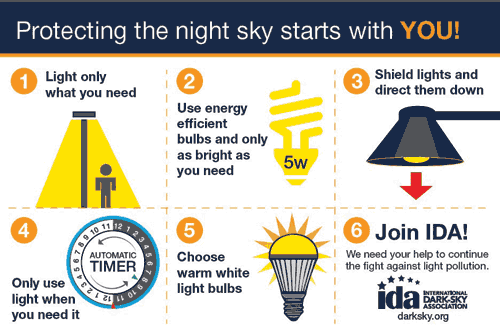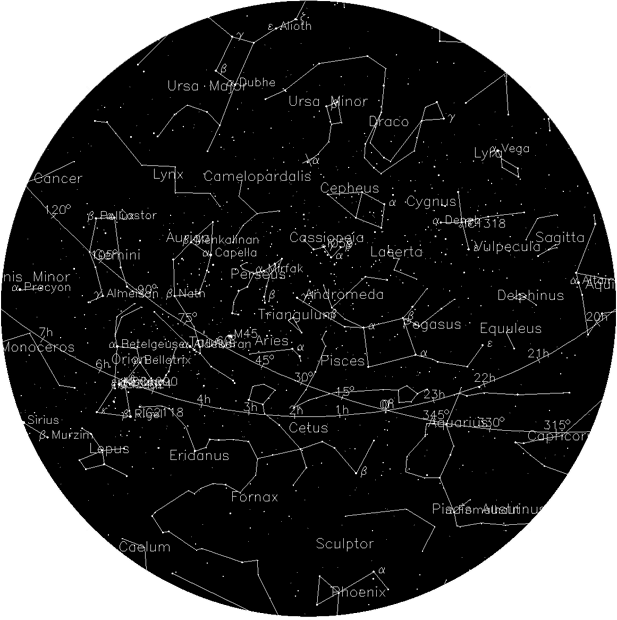Moab
UT (at City Hall)
38O34’ N Latitude 109O33’ W Longitude
4048 ft - 1234 m |
DARK SKY HAPPENINGS - April 2018
Moab Dark Skies mission is to promote the appreciation and conservation of Moab’s valuable and rare dark skies. The Moab Dark Skies was established by the Friends of Arches and Canyonlands Parks in conjunction with the National Park Service and Utah State Parks Division of Natural Resources.
The Economics of Dark Skies
By Zacharia Levine
Sunrise-Sunset
for April
(The time of sunrise and sunset assumes a flat horizon. Actual time may vary depending upon the landscape.) |
Date |
Sunrise |
Sunset |
1 |
7:02 am |
7:41 pm |
2 |
7:01 am |
7:42 pm |
3 |
6:59 am |
7:43 pm |
4 |
6:58 am |
7:44 pm |
5 |
6:56 am |
7:45 pm |
6 |
6:55 am |
7:46 pm |
7 |
6:53 am |
7:47 pm |
8 |
6:52 am |
7:48 pm |
9 |
6:50 am |
7:49 pm |
10 |
6:49 am |
7:50 pm |
11 |
6:47 am |
7:51 pm |
12 |
6:46 am |
7:52 pm |
13 |
6:44 am |
7:53 pm |
14 |
6:43 am |
7:54 pm |
15 |
6:42 am |
7:54 pm |
16 |
6:40 am |
7:55 pm |
17 |
6:39 am |
7:56 pm |
18 |
6:37 am |
7:57 pm |
19 |
6:36 am |
7:58 pm |
20 |
6:35 am |
7:59 pm |
21 |
6:33 am |
8:00 pm |
22 |
6:32 am |
8:01 pm |
23 |
6:30 am |
8:02 pm |
24 |
6:29 am |
8:03 pm |
25 |
6:28 am |
8:04 pm |
26 |
6:27 am |
8:05 pm |
27 |
6:25 am |
8:06 pm |
28 |
6:24 am |
8:07 pm |
29 |
6:23 am |
8:08 pm |
30 |
6:22 am |
8:09 pm |
|
Simply stated, protecting the Colorado Plateau’s dark skies makes cents! This article provides a brief introduction to various topics that fall under the umbrella of dark skies economics.
First, protecting dark skies often involves a reduction in the number of lighting fixtures, lighting-hours, wattages, and color temperatures. Each of these actions results in less light pollution and an associated cost savings to property owners and managers. Based on the findings of a recently conducted lighting audit of publicly owned light fixtures in the City of Moab, University of Utah graduate students Nathan Jellen and Adam Dalton suggest the City could save nearly $16,000 per year by upgrading streetlights, exterior building lights, and shielding fixtures to dark sky standards. The payoff time for this capital improvement, aside from labor costs, is estimated to be a little more than two years. Kudos to the Moab City Council for allocating funds in their 2018-19 budget to make the recommended changes! Of course, removing unnecessary lighting altogether could result in even greater savings. Further, if the costs of mitigating climate change are internalized, the associated 38% reduction in greenhouse gas emissions per year provides further support for dark skies protection.
Saving money represents one side of dark skies economics—generating revenue from dark skies as a desired environmental resource is another. The revenue potential associated with darks skies is starting to receive a lot of attention, and for good reason. The old law of supply and demand suggests that prices rise when certain products or services exhibit increasing demand and decreasing supply. As the global population continues to urbanize, fewer people have access to pristine, dark skies. Fewer than 10% of Americans can see the Milky Way on a regular basis. At the same time, interest in dark skies and dark skies tourism is on the rise. Dark Skies programs are the best attended programs at national parks and many state parks in the Colorado Plateau. The Utah Office of Tourism now has a page on its website dedicated to dark skies and astrotourism (https://www.visitutah.com/things-to-do/dark-sky-parks/).
In a recent study conducted by David Mitchell and Terrell Gallaway, economists at Mississippi State University, more than 50% of the visitors they surveyed across four National Parks expressed a willingness to pay something to preserve dark skies in the respective surrounding regions. In a separate study, the same authors projected that visitors to national parks in the Dark Sky Cooperative would spend roughly $2.5 billion over the next 10 years, which would lead to 52,000 jobs and $1.1 billion in wages. Several major travel companies and resort destination companies are taking note and now offer star gazing and nighttime activities in their trip packages. While some may disagree with the approach, the monetization of our dark skies, perhaps, will increase our ability to protect them!
Note: Hold the star chart high above your head and match the compass directions to the direction you are facing. Adjust the star chart by orienting Ursa Major (Big Dipper) to match its position in the sky and pull the edges down to create a dome.
The star chart approximates the sky from astronomical twilight to midnight. As the night and month progresses, the constellations shift toward the northwest. The celestial equator is measured in hours (h).
The ecliptic is measured in degrees
.
|

